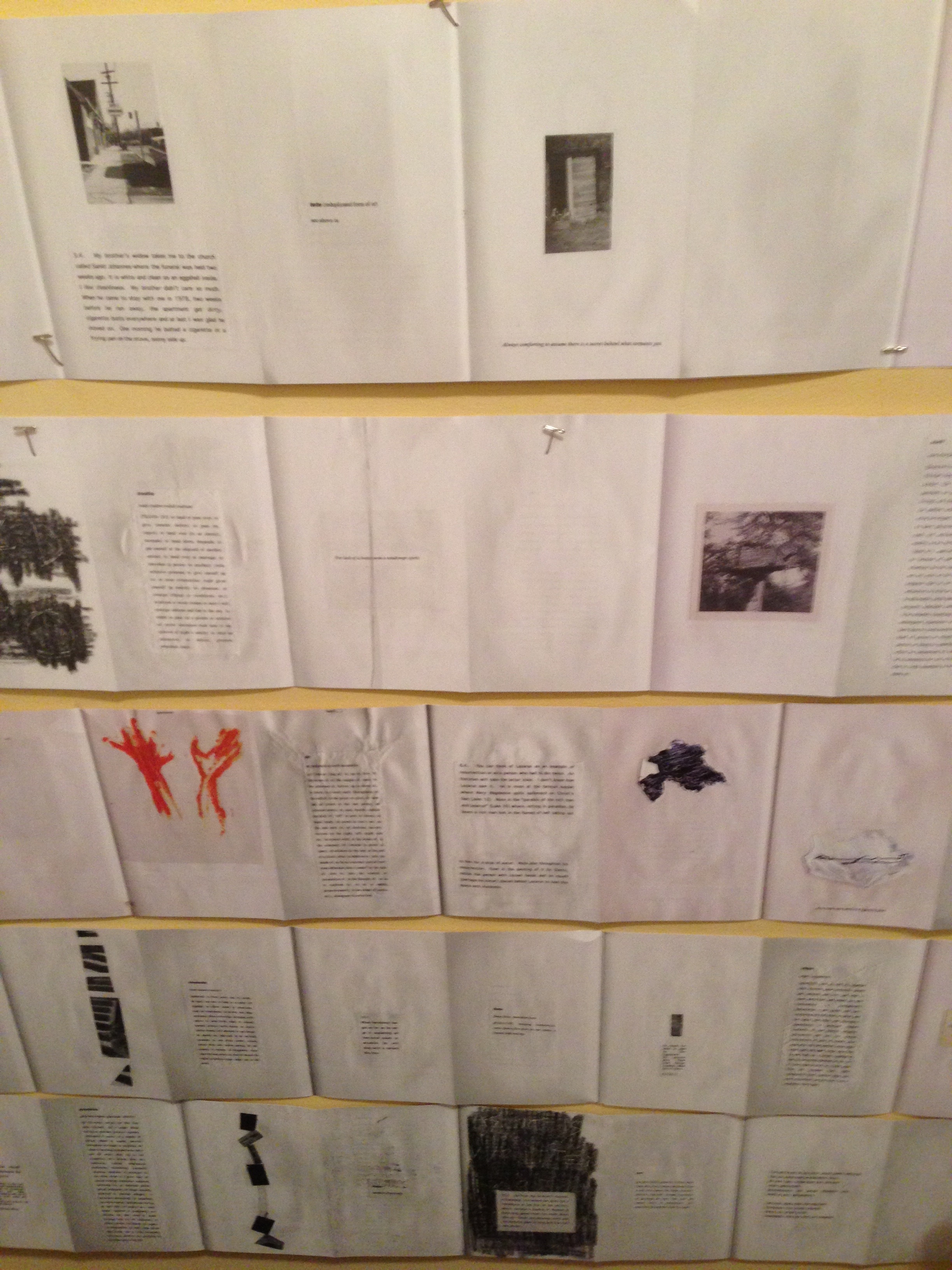An overview of
Nox
by Anne Carson
2.New Directionsa
a.2010
Who were you?
Anne Carson
Nox summarized (in two sentences or less)
Nox by Anne Carson is a deeply personal, accordion-style "book" that serves as an elegy for the poet's late brother, Michael. Through a mix of poetry, prose, and visual elements, Carson explores themes of loss, memory, and the complexities of human relationships, all while trying to translate a Latin poem by Catullus that also mourns a lost sibling.
Nox Trivia and/or (Un)fun Facts
The accordion-style format of "Nox" isn't just a gimmick; it's a metaphor for the unfolding and refolding of memories, much like how we revisit and store away thoughts of lost loved ones.
The book is almost impossible to read in a traditional linear fashion. This design choice mimics the non-linear way we experience grief and memory.
Anne Carson is not just a poet but also a classicist, and "Nox" is a blend of her academic and creative worlds. It's like she's having a scholarly chat with Catullus across millennia, all while pouring out her heart.
Why Nox Is Challenging
Format: That accordion thing is cool but also disorienting. You can't just flip back a page; you've got to navigate this long, unfolding strip.
Non-Linearity: It's not a straightforward narrative. It's fragmented, like shards of a broken mirror you're trying to piece together.
Multimedia: It's not just words. There are photos, scraps, and even Latin translations. Your brain's gotta shift gears constantly.
Emotional Weight: This isn't light reading. It's heavy, it's raw, and it demands emotional investment.
Intellectual Depth: Between the Catullus references and the footnotes, you might feel like you're in a Classics course.
Why Nox Is Worth Reading
That accordion-style design isn't just eye candy; it's a storytelling device. It forces you to engage with the book in a way that mimics the unfolding of memory and the complexity of grief. It's like Carson's saying, "You can't just skim this; you're in it with me." It's a book, it's an art piece, it's an emotional rollercoaster—all rolled into one. How many books make you rethink the act of reading itself?
Who Nox Is For
Nox is definitely not for the casual, beach-read crowd. It's for the intellectual adventurers, the ones who love to dive deep into the human psyche. If you're into experimental formats, classical references, and you don't mind getting a little emotional, this is your jam. It's also a hit for anyone who's dealt with loss and is tired of the Hallmark-card takes on grief. So, if you're looking for a reading experience that's as much a tactile and visual journey as it is a literary one, "Nox" is gonna be right up your alley.
What Nox Looks Like

I repurposed a copy of Nox as wallpaper for a coffin-sized room I was renting c.2013.
How to Read Nox
Ditch Linearity: Forget the usual start-to-finish reading. This one's more like a jazz improvisation than a scripted play.
Physical Space: You'll need room to unfold it, literally. Think of it as a physical journey as much as a literary one.
Multiple Passes: First time, just let it wash over you. Second time, maybe dive into the Latin and footnotes. It's like peeling an onion—each layer has its own kick.
Embrace the Fragmented: Don't stress if it feels disjointed. That's the point. Grief isn't a neat package, and neither is "Nox."
Personalize It: Take notes, jot down thoughts, or even sketch in the margins. Make the experience yours.
Context Dive: If you're up for it, read Catullus' Poem 101. It's the ancient echo in Carson's modern lament.
Feel It: Don't just read with your eyes; use your hands, your sense of space. It's almost like a tactile poem.
Discussion Questions about Nox
Nox Research Prompts for Postdocs:
-
Form as Function: How does the accordion-style format serve as an extension of the book's thematic elements, like memory and grief? Is it merely aesthetic, or does it have a deeper semiotic meaning?
Translation as a Metaphor: Anne Carson is translating Catullus, but she's also translating her own emotions and memories. How does the act of translation serve as a metaphor for the entire work?
Intertextuality: How does Carson's use of Catullus' Poem 101 enrich or complicate the narrative? Does it serve as a parallel, a contrast, or something else entirely?
Fragmentation and Wholeness: The book is fragmented in form and content, yet it aims to capture a whole experience. How does Carson reconcile these contradictions?
Materiality and Immateriality: How does the physicality of the book interact with the immaterial aspects of memory and loss? Does the tactile experience of handling the book contribute to its emotional impact?
The Unsayable: Carson leaves many things unsaid or implied. How does this reflect the ineffability of grief and memory?
Temporal Dissonance: How does "Nox" play with time, intertwining the ancient with the modern? What does this say about the universality of its themes?
Reader's Role: How does the book challenge traditional reader expectations and engagement? Does it redefine the act of reading?
Ethics of Representation: Carson includes real artifacts and letters from her brother. What are the ethical implications of this, especially when dealing with a real person's life and death?
Emotion vs. Intellect: The book is emotionally charged but also intellectually dense. How does Carson balance these two, and what is the impact on the reader?
Nox Conversation Starters for Normal People:
- Format Choices: Why do you think Anne Carson chose an accordion-style format for "Nox"? How does it affect your reading experience?
Themes of Loss: How does Carson explore the theme of loss? Are there specific passages that stood out to you?
Catullus Connection: Why include a Latin poem from ancient Rome? How does it relate to Carson's own story?
Visual Elements: What role do the photographs and other visual elements play in the book? Do they enhance the narrative?
Non-Linear Structure: How does the fragmented, non-linear structure reflect the book's themes?
Personal vs. Universal: How does Carson make a deeply personal story resonate on a universal level?
Language and Translation: What role does language—specifically the act of translating Latin—play in the book?
Emotional Impact: How did the book make you feel? Was it effective in conveying the emotional weight of grief?
Reader Engagement: How does "Nox" challenge or change the way you interact with a book?
Interdisciplinary Approach: "Nox" blends poetry, prose, and visual art. How does this interdisciplinary approach affect your understanding of the work?
Questions about Nox that you can ask your dog:
- Big Foldy Book: "Nox" is like a big, long paper that folds out. It's like a super-long birthday card!
Pictures and Words: The book has pictures and words mixed together. It's like a scrapbook grandma might make.
Sad Story: The lady who wrote it is sad because she misses her brother. It's like when you miss your friend and want to see them again.
Old Poem: She talks about a very old poem that's also about missing someone. Imagine a really, really old song that talks about the same thing.
Hard to Read: This book isn't easy to read like your picture books. Even grown-ups find it tricky!
Special Box: The book comes in a special box. It's like a treasure chest for a story!
The Most Amusing Nox Review I Can Find
how are you supposed to review an elegy?
★★★★☆
—Hannah via Goodreads
—Hannah via Goodreads
